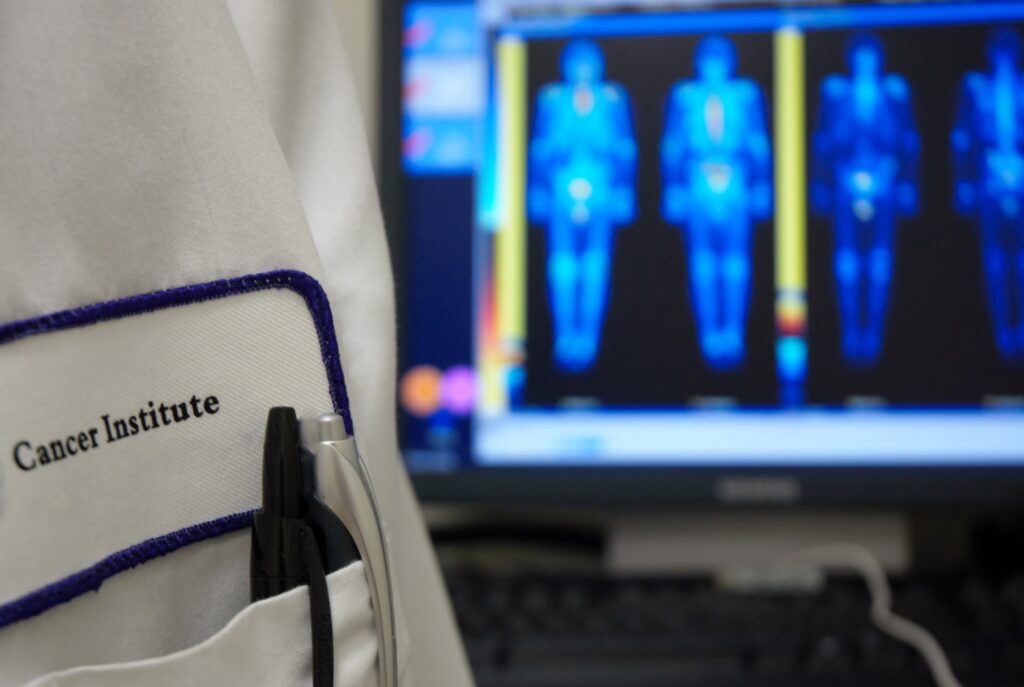Medical imaging revolutionises oncology, enhancing early detection, precise staging, and targeted treatment, significantly improving patient outcomes.
Charting the Course of Cancer Care
The medical field of oncology is dedicated to studying, diagnosing, treating, and preventing cancer. It’s a field that has witnessed both heartbreaking challenges and remarkable triumphs. Cancer, characterised by the uncontrolled growth and spread of abnormal cells, is among the leading causes of death worldwide. Early detection and effective treatment are crucial in enhancing cancer patients’ survival and quality of life. The journey from the initial suspicion of cancer to its treatment is complex, requiring precise diagnostic and therapeutic strategies.
Medical imaging has become a necessary tool in this area. It encompasses various techniques employed to visualise the human body’s interior for clinical analysis and medical intervention. In the context of oncology, medical imaging plays a multifaceted role. It aids in early detection, when cancer may be most treatable, by providing a non-invasive way to visualise tumours. The use of techniques such as X-rays, Computed Tomography (CT) scans, Magnetic Resonance Imaging (MRI) and Positron Emission Tomography (PET) scans are frequently used to detect and locate tumours, even in their nascent stages.
Beyond detection, medical imaging is crucial in cancer staging – determining the extent of cancer spread. This information is vital for planning the most effective treatment strategy. For instance, imaging can reveal whether a tumour has metastasised to other parts of the body, which can significantly influence treatment decisions. During treatment, medical imaging continues to play a role, helping clinicians assess the effectiveness of treatment modalities like chemotherapy, radiation, or surgery and make necessary adjustments. In essence, medical imaging acts as a powerful ally in oncology, guiding clinicians at every step of the cancer care continuum, from diagnosis to treatment monitoring and follow-up.
Historical Perspective
The evolution of medical imaging in oncology represents a journey of remarkable technological advancements, transforming how cancer is diagnosed, staged, and treated.
Early Techniques in Medical Imaging
- X-rays (Late 19th Century): The discovery of X-rays by Wilhelm Conrad Roentgen in 1895 marked the advent of medical imaging. Initially used to visualise bone fractures, X-rays were soon employed to detect certain types of tumours and cancers, particularly those involving bones or dense tissues.
- Radionuclide Scanning (1950s): This technique involved the use of radioactive substances to highlight organs and structures. It was a precursor to more sophisticated imaging methods and was instrumental in detecting abnormalities in organs and tissues.
- Ultrasound (1950s-1960s): The development of ultrasound imaging provided a safer, radiation-free method for viewing soft tissues. Although its early use in oncology was limited, it laid the groundwork for more detailed imaging methods.
Modern Advancements in Medical Imaging
- Computed Tomography (CT Scans, 1970s): CT scans revolutionised medical imaging by providing detailed cross-sectional images of the body. They allowed for better differentiation of soft tissues, crucial for tumour detection, and became essential in planning radiation therapy.
- Magnetic Resonance Imaging (MRI, 1980s): MRI offered an even more detailed view of soft tissues without the use of ionising radiation. It became instrumental in diagnosing brain and spinal cord tumours and breast cancer screening.
- Positron Emission Tomography (PET, 1980s-1990s): PET scans, often used in conjunction with CT scans (PET/CT), provided metabolic information about tissues and organs. This was groundbreaking for detecting cancer metastases and evaluating the effectiveness of cancer treatments.
- Digital Advancements (2000s-present): The integration of digital technology led to enhanced imaging quality, 3D reconstructions, and the ability to share and analyse images digitally. This era also saw the advent of digital mammography, which improved breast cancer screening.
- AI and Machine Learning: Recent years have witnessed the introduction of AI in interpreting medical images, enabling the potential for faster, more accurate diagnoses and personalised treatment plans.
The evolution from basic X-rays to advanced techniques like PET/CT scans and AI-augmented imaging represents a paradigm shift in oncology. Each advancement has provided oncologists with clearer, more detailed views of cancer, greatly enhancing the accuracy of diagnoses, the precision of treatments, and, ultimately, patient outcomes.
Types of Medical Imaging in Oncology
Various medical imaging techniques play a pivotal role in cancer detection and management. Each type of imaging offers unique advantages and is used for different aspects of cancer care.
X-rays and Cancer Detection
- X-rays: The oldest form of medical imaging, x-rays are primarily utilised to detect bone abnormalities and certain types of cancer, such as lung cancer.
- Function: They work by passing controlled amounts of radiation through the body, capturing images of the contrast between different tissues. Tumours or abnormalities in dense tissues, like bones, can often be detected due to their different radiation absorption compared to normal tissues.
Computed Tomography (CT) Scans
- Role in Tumour Size and Location: CT scans provide detailed cross-sectional images of the body, which is crucial in oncology for determining the size, shape, and location of tumours.
- Function: By combining multiple X-ray images taken from different angles, CT scans create a comprehensive view of the area of interest, helping doctors to locate the tumour precisely and understand its relation to surrounding structures. This is essential for planning surgeries, radiation therapy, and monitoring tumour response to treatment.
Magnetic Resonance Imaging (MRI)
- Effectiveness in Soft Tissue Cancers: MRI is exceptionally effective in diagnosing and assessing soft tissue cancers, including brain, spinal cord, breast, and prostate cancers.
- MRI: Uses strong magnetic fields and radio waves to generate detailed images of the internal structures within the body. It is particularly adept at differentiating between normal and cancerous tissues, making it invaluable for both initial cancer diagnosis and follow-up evaluations.
Positron Emission Tomography (PET) Scans
- Assessment of Metabolic Activity: PET scans are used to observe the metabolic activity of cells in the body.
- Function: Patients are injected with a small amount of radioactive glucose, and the PET scanner detects areas with increased glucose consumption. Since cancer cells often consume glucose at higher rates than normal cells, PET scans can detect early cancerous changes, assess whether the cancer has spread, and evaluate the effectiveness of ongoing treatment.
Ultrasound in Oncology
- Role: Ultrasound is used in oncology primarily for cancers of the breast, liver, and reproductive organs.
- Function: It uses high-frequency sound waves to create images of the inside of the body. Ultrasound is beneficial for guiding biopsies, assessing tumours in organs like the liver, and monitoring tumour changes during treatment.
Each of these imaging modalities offers different insights into cancer’s presence, behaviour, and response to treatment, playing a key role in the comprehensive management of the disease.
Detection and Diagnosis
Medical imaging has been a revolutionary force in the early detection and accurate diagnosis of cancer, fundamentally altering the landscape of oncology and patient outcomes.
Revolutionising Early Detection of Cancer
- Early Detection: The advent of advanced imaging techniques has made it possible to detect cancers at much earlier stages than was previously possible. Early detection is critical in cancer treatment, as it often means the cancer is smaller and has not spread, allowing for more effective treatment options and a higher chance of successful recovery.
- Screening Programs: Routine screening programs using imaging technologies, such as mammography for breast cancer and low-dose CT scans for lung cancer in high-risk populations, have significantly increased the detection of these cancers at earlier, more treatable stages.
Role in Accurate Diagnosis and Differentiation:
- Precise Diagnosis: Imaging modalities like MRI, CT, and PET scans provide detailed information about the size, shape, location, and even the type of tissue involved in a tumour. This helps distinguish benign from malignant tumours and accurately diagnose the type of cancer.
- Differentiation of Cancer Types: For instance, MRI’s ability to differentiate soft tissue structures makes it particularly useful in diagnosing brain tumours, where it is vital to distinguish between different types of brain tissue. Similarly, PET scans can differentiate between active and inactive (scar) tissue, aiding in understanding the cancer’s behaviour.
Case Studies and Statistics Demonstrating Improved Outcomes
- Breast Cancer Screening: Regular mammography screening has demonstrated a reduction in breast cancer mortality by detecting cancer early. A study published in the journal Cancer indicated that women who underwent regular mammography screening had a 60% lower risk of dying from breast cancer within 10 years of diagnosis and a 47% lower risk 20 years after diagnosis compared to those who did not have regular screenings.
- Lung Cancer Screening: A landmark trial, the National Lung Screening Trial (NLST), demonstrated that screening with low-dose CT scans in high-risk individuals (heavy smokers) reduced lung cancer deaths by 20% compared to screening with standard chest X-rays.
- Colon Cancer: The use of colonoscopy, a type of imaging, has been instrumental in decreasing colon cancer rates through the detection and removal of precancerous polyps.
These examples underscore the vital role that medical imaging plays in the early detection and accurate diagnosis of cancer, leading to significantly improved patient outcomes. By catching cancer early and understanding its specifics, medical imaging directly contributes to more effective and personalised treatment strategies.
Staging of Cancer
The staging of cancer is a crucial step in the management of the disease, as it determines the extent of its spread and is fundamental in guiding treatment decisions.
Importance of Staging in Determining Cancer Spread
- Defining the Extent: Staging describes the severity of an individual’s cancer based on the size of the original tumour and the extent of its spread within the body. Accurate staging is vital as it influences the choice of treatment strategies, helps predict prognosis, and allows for the standardisation of cancer care, facilitating communication among healthcare providers and comparison of clinical trial results.
- Determining Treatment Approach: For instance, a localised cancer (confined to the site of origin) might be treated differently from a metastatic cancer (spread to other parts of the body). Staging helps in determining whether to prioritise local treatments like surgery or radiation, systemic treatments like chemotherapy, or a combination.
Imaging Techniques Used in Staging Various Types of Cancer
- Computed Tomography (CT) Scans: Widely used in staging for several types of cancer, including lung, colorectal, and lymphoma. CT scans are excellent for visualising the chest, abdomen, and pelvis, assessing the size of the tumour, and checking for the spread to lymph nodes and distant organs.
- Magnetic Resonance Imaging (MRI): Preferred for detailed images of soft tissues, making it invaluable in staging cancers such as brain, spinal, prostate, and liver cancers. MRI is particularly useful in assessing the invasion of cancer into surrounding tissues.
- Positron Emission Tomography (PET) Scans: Often combined with CT scans (PET/CT), these are used to detect the metabolic activity of cancer cells throughout the body. PET scans are particularly useful in identifying metastases, even when they are not yet large enough to be visualised by other imaging methods.
- Bone scans: These are used to determine whether cancer has spread to the bones. This is particularly important in cancers prone to bone metastasis, such as breast and prostate cancers.
- Ultrasound: Sometimes used in staging cancers of the abdomen, such as liver cancer, and in gynaecological cancers.
Impact of Accurate Staging on Treatment Planning
- Tailored Treatment: Accurate staging allows clinicians to tailor treatment plans to the individual patient’s needs. For example, a patient with early-stage cancer might benefit from surgery alone, whereas advanced-stage cancer might require a combination of surgery, radiation and chemotherapy.
- Prognostic Value: Staging provides valuable prognostic information. Patients with early-stage cancers generally have a better prognosis than those with advanced-stage cancers.
- Clinical Trials and Research: Accurate staging is essential for the stratification of patients in clinical trials, ensuring that treatments are tested on appropriately grouped patients and contributing to the advancement of cancer research.
The accurate staging of cancer through various imaging techniques is a cornerstone in the management of cancer, directly impacting treatment decisions, prognostic assessments, and the overall approach to patient care.
Treatment Planning and Monitoring
Medical imaging plays a critical role in informing treatment decisions, guiding precision medicine, monitoring treatment response, and enabling adaptive changes in cancer management.
Informing Treatment Decisions (Surgery, Radiation, Chemotherapy)
- Surgery: Imaging helps determine the size and location of the tumour, assess whether it is operable, and guide the surgical plan. For instance, MRI can provide detailed images of brain tumours, assisting neurosurgeons in planning precise removal while avoiding critical brain areas.
- Radiation Therapy: Techniques like CT and MRI are used to delineate the exact contours of a tumour, ensuring accurate targeting in radiation therapy and minimising exposure to healthy tissues.
- Chemotherapy: Imaging, especially PET scans, can identify the most active tumour sites, which can influence the choice of chemotherapeutic agents and dosages.
Role in Precision Medicine and Targeted Therapies
- Personalised Treatment Plans: Precision medicine involves tailoring treatment to the individual characteristics of each patient’s cancer. Imaging plays a key role in providing detailed information about the tumour’s characteristics.
- Targeted Therapy: For example, PET scans can identify specific molecular targets or receptors on tumour cells, guiding the use of targeted therapies that hone in on these features.
Monitoring Response to Treatment Using Various Imaging Modalities
- Evaluating Treatment Effectiveness: Imaging is used to monitor the tumour’s response to treatment over time. Techniques like CT, MRI, and PET scans can show changes in the tumour’s size, shape, or metabolic activity, indicating how well the treatment is working.
- Early Detection of Recurrence: Regular imaging can detect cancer recurrence early. For instance, mammography or breast MRI can identify recurrences in breast cancer patients post-treatment.
Adaptive Changes in Treatment Based on Imaging Findings
- Adjusting Treatment Plans: If imaging shows that a tumour is not responding to the current treatment or if it reveals new areas of spread, clinicians can adjust the treatment plan accordingly. This might involve changing chemotherapy drugs, modifying radiation therapy plans, or considering surgical options.
- Real-time Decision Making: In some cases, such as during radiation therapy, imaging can be used in real-time to adjust treatment. Techniques like Image-Guided Radiation Therapy (IGRT) use imaging during each radiation treatment session to target the tumour accurately, adapting to changes in size or position.
Medical imaging is an indispensable tool in modern oncology. It guides clinicians in making informed treatment decisions, enables personalised and targeted therapies, assists in monitoring treatment response, and facilitates adaptive changes in treatment strategies, ultimately contributing to improved patient outcomes.
Future of Medical Imaging in Oncology
The field of medical imaging is continuously evolving, with emerging technologies and the integration of artificial intelligence (AI) and machine learning (ML) poised to significantly impact oncology.
Emerging Imaging Technologies and Their Potential Impact
- Advanced Molecular Imaging: Techniques like hyperpolarised MRI offer the ability to observe metabolic processes in real-time, providing insights into the metabolic activity of tumours. This could enhance the early detection and characterisation of cancer.
- Optical Imaging Techniques: Technologies like photoacoustic imaging and optical coherence tomography are being explored for cancer diagnosis. These methods offer high-resolution, real-time images and could be particularly useful for skin and breast cancer imaging.
- Nanotechnology in Imaging: The use of nanoparticles in imaging, known as nanoradiology, can improve the specificity and sensitivity of cancer detection. Nanoparticles can be engineered to target specific cancer cells, potentially allowing for earlier detection and more precise imaging.
The Role of AI and Machine Learning in Enhancing Imaging Techniques
- Improved Diagnosis Accuracy: AI algorithms can analyse imaging data with high precision, often identifying subtle patterns that the human eye may miss. This can lead to more accurate diagnoses and less variability in interpretation.
- Predictive Analytics: AI can assist in predicting tumour behaviour, response to treatment, and potential recurrence by analysing imaging data alongside other patient data. This could lead to more personalised and effective treatment plans.
- Efficiency in Imaging Workflows: AI can streamline imaging workflows, reducing the time required for image analysis and reporting. This efficiency can lead to improved diagnosis and treatment.
Predictions for How Imaging Will Continue to Transform Oncology
- Personalised Treatment Planning: As imaging technologies become more sophisticated, they will play an even more significant role in creating personalised treatment plans. By providing detailed insights into the biological characteristics of tumours, imaging will enable more targeted and effective therapies.
- Integration with Other Data: Imaging data will increasingly be integrated with genetic, molecular, and clinical data, offering a more comprehensive view of cancer. This integration will enhance the precision medicine approach in oncology.
- Early Detection and Prevention: Emerging imaging technologies, combined with AI, could lead to breakthroughs in early cancer detection and even in predicting the likelihood of cancer development, shifting the focus towards prevention and early intervention.
- Real-time Monitoring and Adaptive Therapies: Future imaging technologies may allow for real-time monitoring of tumour responses during treatment, facilitating adaptive therapies that can be modified based on immediate feedback from imaging results.
The future of medical imaging in oncology holds tremendous promise. Emerging technologies, augmented by AI and ML, are set further to revolutionise cancer diagnosis, treatment planning, and monitoring, leading to more personalised, effective, and efficient cancer care.
Conclusion
Medical imaging has been instrumental in transforming the landscape of oncology, playing a critical role in every step of the cancer care continuum. From early detection and accurate diagnosis to staging, treatment planning, and monitoring response to therapy, imaging technologies have provided invaluable insights that have directly impacted patient care and outcomes.
Summarising the Critical Role of Medical Imaging
- Early Detection and Diagnosis: Imaging techniques like mammography, CT scans, MRI, and PET scans have enabled the early detection of cancers, often before symptoms arise, significantly improving the chances of successful treatment.
- Staging of Cancer: Through detailed visualisation of tumour size, location, and spread, imaging has been pivotal in accurately staging cancer, which is crucial for choosing the most appropriate and effective treatment strategy.
- Guiding Treatment: Imaging informs surgical planning, radiation therapy, and the use of chemotherapy, helping to target treatments more precisely and effectively.
- Monitoring Treatment Response: Regular imaging allows for the ongoing assessment of how well a cancer is responding to treatment, facilitating timely adjustments to therapy when necessary.
- Personalised Medicine: With advancements in imaging, there’s a move towards more personalised cancer treatment, where imaging results are integrated with genetic and molecular data to tailor therapy to individual patient profiles.
Reflection on Advancements and Future Directions
- The field of medical imaging has seen remarkable technological advancements, from the early days of simple X-rays to the complex, high-resolution imaging of today. Techniques like molecular imaging, AI-enhanced image analysis, and nanotechnology in imaging are set to redefine cancer detection and treatment.
- Role of AI and Precision Medicine: AI and machine learning are revolutionising imaging, enhancing diagnostic accuracy, and streamlining workflows. The integration of imaging data with genomic and other biomarker data is paving the way for precision medicine in oncology, offering highly specific treatments for individual tumour characteristics.
- Future Directions: The future of medical imaging in oncology is bright, with ongoing research focused on improving the sensitivity and specificity of imaging modalities, developing non-invasive imaging techniques, and further integrating imaging with other forms of cancer data for comprehensive care.
In summary, medical imaging remains a cornerstone in the fight against cancer, continually evolving to meet the challenges of this complex disease. The ongoing advancements in imaging technology and its integration with other biomedical fields have great potential for enhancing cancer care, ultimately leading to better patient outcomes and a deeper understanding of cancer.
Disclaimer
The content provided in this article is intended for informational and educational purposes only. It does not constitute medical advice, diagnosis, or treatment recommendations and should not be relied upon as a substitute for professional medical consultation. While every effort has been made to ensure the accuracy and reliability of the information presented, Open Medscience makes no representations or warranties, express or implied, regarding the completeness, accuracy, or applicability of the content to individual circumstances.
The article discusses medical imaging technologies and their role in oncology based on current understanding and research at the time of publication (7 January 2024). Developments in medical science, clinical guidelines, or technology may have occurred since its publication. Readers are strongly advised to consult qualified healthcare professionals regarding any medical condition or health concern.
Open Medscience disclaims all liability for any loss, damage, or injury resulting from reliance on information contained in this article. Inclusion of any specific imaging technique, technology, or case example does not imply endorsement, suitability, or recommendation for any individual patient or clinical scenario.
By accessing and reading this content, you acknowledge and accept that Open Medscience shall not be held liable for any actions taken or not taken based on the information provided herein.
You are here: home » diagnostic medical imaging blog »



